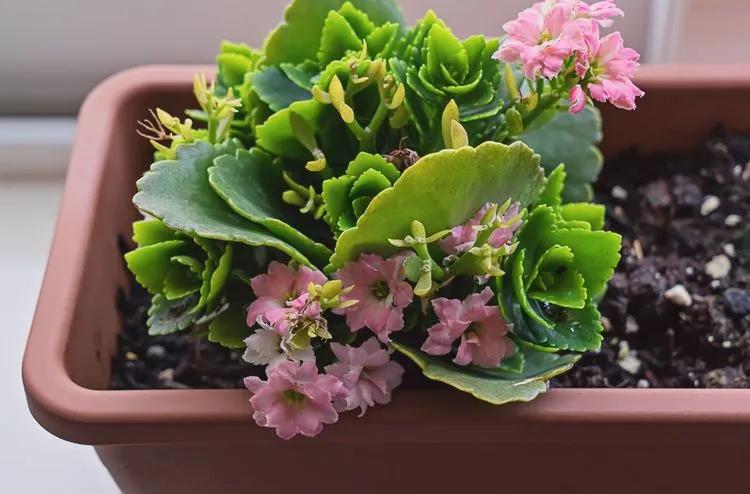 Kalanchoes are popular succulent houseplants that are favored because of their undemanding nature and pretty blossom. Brightly colored tiny flowers appear in a variety of shades, from red, magenta, yellow, and orange to white. The best-known species is Kalanchoe blossfeldiana, also known as flaming Katy, panda plant, or widow's thrill.
Kalanchoes are popular succulent houseplants that are favored because of their undemanding nature and pretty blossom. Brightly colored tiny flowers appear in a variety of shades, from red, magenta, yellow, and orange to white. The best-known species is Kalanchoe blossfeldiana, also known as flaming Katy, panda plant, or widow's thrill.
Lighting
Kalanchoe is a sun-loving plant: indoors, it requires around 12 hours of light daily. Thus, it is recommended to place it in the sunniest parts of your home: north-facing rooms are not suitable. Choose east or west windows during the spring-summer season, and move the plant to south-facing window sills during fall and winter. If you think that sunlight at your place won’t satisfy the needs of the flower, try using LED lamps. With the proper amount of light, kalanchoe will bloom constantly.
Temperature
Kalanchoe is not very picky regarding the temperatures regime. It will thrive in almost any conditions: the only rule is not to go to extremes. During the hot season, temperatures can vary from 64 to 82˚F (18-28˚C), and during fall and winter, from 57 to 64˚F (14-18˚C). This temperature regime during the dormancy period is crucial: the plant rests and lays new buds. Without dormancy, kalanchoe will not be able to bloom. Also, the plant is not likely to survive temperature drops to 50˚F (10˚C) and less.
Watering
For irrigation, use soft and well-settled water. This plant is succulent, so overwatering might lead to serious issues like rotting. Water kalanchoe only after the top layer of the potting mix dries out. However, underwatering will lead leaves to fall off, so be attentive. In winter, water your green plant less frequently.
Spraying
 Kalanchoe does not require regular misting: as any succulent, it is used to arid conditions so that humidity in most homes will suit it. You can spray the plant occasionally to remove the dust. Some green thumbs also mist these species during the summer heat, but this is not obligatory. The leaf plates of such a plant are fleshy, sometimes there is pubescence on their surface, so the moisture evaporates very slowly.
Kalanchoe does not require regular misting: as any succulent, it is used to arid conditions so that humidity in most homes will suit it. You can spray the plant occasionally to remove the dust. Some green thumbs also mist these species during the summer heat, but this is not obligatory. The leaf plates of such a plant are fleshy, sometimes there is pubescence on their surface, so the moisture evaporates very slowly.
Fertilizer
We recommend fertilizing the bush not only in the spring-summer but also in the fall when its buds are forming. Use liquid fertilizers for cacti and succulents twice a month. Remember to dilute the recommended dose in two: excessive fertilizing can seriously harm the plant.
Pruning
Most species of kalanchoe drop off their old leaves, so old branches might lose their decorativeness. Such soots can be cut off. Perform pruning during the active growth season, and always use sterile and very sharp instruments. Cut leaves and branches can be planted as well as kalanchoe, like most succulents, can develop from a single leaf.
Purchase and selection of a plant
When choosing a decorative flowering Kalanchoe, pay attention to the number of blossoming flowers. Better to take a plant with more unopened buds - in this case, you will have more time to enjoy the blooming.
Transplantation
 Kalanchoe is transplanted every two years to refresh the soil or change a pot for an overgrown plant. The perfect potting mix consists of a mixture of turf, peat soil, and some sand. Drainage made of pebbles, expanded clay, or broken brick is required at the bottom of the pot to prevent root rot.
Kalanchoe is transplanted every two years to refresh the soil or change a pot for an overgrown plant. The perfect potting mix consists of a mixture of turf, peat soil, and some sand. Drainage made of pebbles, expanded clay, or broken brick is required at the bottom of the pot to prevent root rot.
Diseases and pests
The most common issues with Kalanchoe include overwatering and lack of light. When the plant does not get enough sunlight, it becomes leggy. Foliage loses its bright color and becomes pale. Also, this might lead to the falling of the leaves.
After abundant flowering, the plant requires a great portion of nutrients to continue its development. If you notice that your pet has stopped growing or lost its leaves just after being in bloom, it is high time you applied some fertilizer. Also, consider replanting kalanachoe to a fresh potting mix; this will help as well.
Other common issues include:
- Leaves become dry and fall off. This might be a sign of underwatering, low humidity, or pest infestation.
- The plant gets brown or black soft spots or mold when it is too humid, especially at low temperatures in poorly ventilated rooms.
- The leaves are large, juicy green, but flowering does not occur. This is a common symptom of overfeeding with fertilizers, especially organic or mineral fertilizers with a high proportion of nitrogen.
